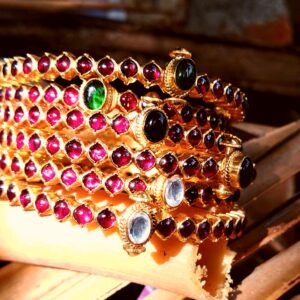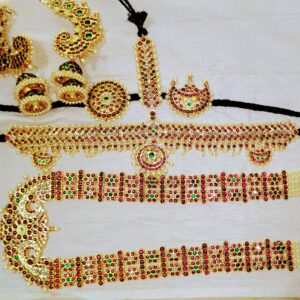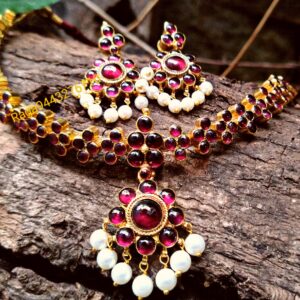Showing 1–12 of 258 results
-
Quick View
Almost every Indian wedding song celebrates the beauty and grandeur of glass bangles. They are not mere ornaments but are a signifying factor for what makes Indian women stand apart in style, tradition, and culture. Right from being considered auspicious to being the symbol of a woman’s marital status, bangles play various roles in the lives of women, particularly in India.
-
Quick View
Almost every Indian wedding song celebrates the beauty and grandeur of glass bangles. They are not mere ornaments but are a signifying factor for what makes Indian women stand apart in style, tradition, and culture. Right from being considered auspicious to being the symbol of a woman’s marital status, bangles play various roles in the lives of women, particularly in India.
-
Quick View
Almost every Indian wedding song celebrates the beauty and grandeur of glass bangles. They are not mere ornaments but are a signifying factor for what makes Indian women stand apart in style, tradition, and culture. Right from being considered auspicious to being the symbol of a woman’s marital status, bangles play various roles in the lives of women, particularly in India.
-
Quick View
Almost every Indian wedding song celebrates the beauty and grandeur of glass bangles. They are not mere ornaments but are a signifying factor for what makes Indian women stand apart in style, tradition, and culture. Right from being considered auspicious to being the symbol of a woman’s marital status, bangles play various roles in the lives of women, particularly in India.
-
Quick View
Bharatanatyam is a major form of Indian classical dance that originated in the state of Tamil Nadu hundreds of years ago. … The performance repertoire of Bharatanatyam, like other classical dances, includes nrita (pure dance), nritya (solo expressive dance) and natya (group dramatic dance).
-
Quick View
Bharatanatyam is a major form of Indian classical dance that originated in the state of Tamil Nadu hundreds of years ago. … The performance repertoire of Bharatanatyam, like other classical dances, includes nrita (pure dance), nritya (solo expressive dance) and natya (group dramatic dance).
-
Quick View
Golden choker necklaces were crafted by Sumerian artisans around 2500 BC and according to curators from the Jewelry Museum of Fine Arts, chokers have been around for thousands of years, first gracing the world’s earliest civilizations: Ancient Egypt, in addition to the Sumerians in Mesopotamia.
-
Quick View
Golden choker necklaces were crafted by Sumerian artisans around 2500 BC and according to curators from the Jewelry Museum of Fine Arts, chokers have been around for thousands of years, first gracing the world’s earliest civilizations: Ancient Egypt, in addition to the Sumerians in Mesopotamia.
-
Quick View
Golden choker necklaces were crafted by Sumerian artisans around 2500 BC and according to curators from the Jewelry Museum of Fine Arts, chokers have been around for thousands of years, first gracing the world’s earliest civilizations: Ancient Egypt, in addition to the Sumerians in Mesopotamia.
-
Quick View
Golden choker necklaces were crafted by Sumerian artisans around 2500 BC and according to curators from the Jewelry Museum of Fine Arts, chokers have been around for thousands of years, first gracing the world’s earliest civilizations: Ancient Egypt, in addition to the Sumerians in Mesopotamia.
-
Quick View
Golden choker necklaces were crafted by Sumerian artisans around 2500 BC and according to curators from the Jewelry Museum of Fine Arts, chokers have been around for thousands of years, first gracing the world’s earliest civilizations: Ancient Egypt, in addition to the Sumerians in Mesopotamia.
-
Quick View
Golden choker necklaces were crafted by Sumerian artisans around 2500 BC and according to curators from the Jewelry Museum of Fine Arts, chokers have been around for thousands of years, first gracing the world’s earliest civilizations: Ancient Egypt, in addition to the Sumerians in Mesopotamia.














